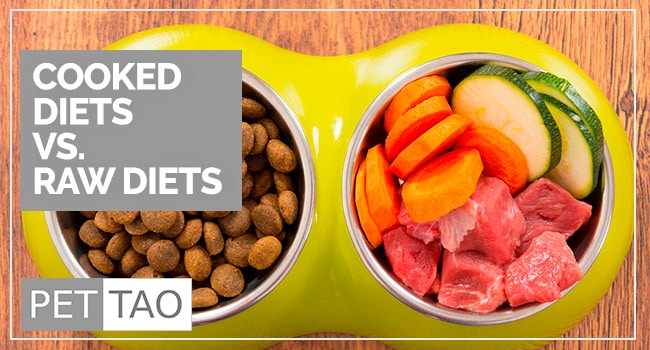You’ve seen “raw pet food diet” in new articles lately, but without much explanation.
Is raw food better or worse than a traditional pet food diet?
What is a Raw Pet Food Diet?
Two major types of raw food diets exist: homemade and commercial.
Companies offer frozen and fresh versions of commercial raw diets. Commercial raw diets are often in meat patty form.
Homemade raw diets include:
- Raw eggs
- Vegetables like broccoli, spinach, and celery
- Apples or other fruit
- Some dairy, such as yogurt
- Muscle meat, still on the bone
- Bones, whole or ground
- Organ meat, such as liver and kidneys
- B.A.R.F. (Biologically Appropriate Raw Food) or Bones And Raw Food.
- PMR (Prey Model Raw).
The B.A.R.F. diet consists of meat, bones, organs, vegetables, cottage cheese, and eggs with shells.
Why Feed Your Pet a Raw Diet?
Many believe their pets need a diet closer to that of wild animals.
For example, if dogs didn’t eat grains in the wild, why feed dogs grains now?
Cooked Meat Contains Carcinogens
According to a study by The American Society for Nutritional Sciences, cooking meat makes the fat toxic and carcinogenic.
Scientists conducted the study, called Meat Consumption Patterns and Preparation, Genetic Variants of Metabolic Enzymes, and Their Association with Rectal Cancer in Men and Women, on humans.
Raw Meats Are Less Allergenic
According to a study in the Journal of Nutrition, cooked proteins can cause allergic reactions whereas raw proteins do not.
Oxford University Press published At War Within The Double-Edged Sword of Immunity, in 1995.
Why is a Cooked Diet Better?
Lisa M. Freeman, DVM, Ph.D., published a study of raw dog food diets in the Journal of the American Veterinary Medical Association in 2001.
Dr. Freeman suggests many pet owners choose a raw diet based on online myths propagated by commercial pet food companies.
She also advises pet parents seeking alternatives to commercial diets to consider a home-cooked diet.
In addition, Dr. Freeman, a nutrition professor at the Cummings School of Veterinary Medicine at Tufts University, argues many benefits attributed to raw diets, such as shiny coats, are actually the result of the higher fat content in some raw diets.
Reason #1: Bacteria Harmful to Humans Lives in Raw Foods
Raw diets can contain known human and canine pathogens such as Salmonella, Campylobacter, Escherichia coli O157:H7, Clostridium perfringens, Clostridium botulinum, and Staphylococcus aureus.
While they may not negatively affect your pet, these bacteria pass through dog stools, leaving your carpets and furniture at risk for contamination as your pet moves throughout the house.
In fact, a 2006 study conducted by the Department of Veterinary Clinical and Diagnostic Sciences at the University of Calgary found 7.1% of 20 commercial raw diets contained a type of salmonella.
The study also found E. coli bacteria in 59.6% of raw meat diets.
In 2004, the FDA issued suggestions for manufacturing raw pet food more safely.
The FDA cited safety concerns about the health risks to owners who handle raw meat.
A cooked cat or dog diet prevents many of these concerns.
Reason #2: Raw Diets Are Less Balanced Than Cooked Diets
Raw diets are difficult and time-consuming to create at home.
Due to their difficulty, many homemade raw diets are inadequate nutritionally and deficient in vitamins and minerals.
The deficiency is due in part to dogs’ inability to digest many raw vegetables. Most of the nutrients in raw vegetables are best accessed after they are slightly cooked and cut into small pieces.
Dogs’ teeth are better suited for chewing meat than raw vegetables. Their mouths do not contain the digestive enzymes necessary to break down plant matter.
Additionally, a dog’s short digestive system is incapable of breaking down raw vegetables.
Nutritional deficiencies can take months to show up, leaving your pet with long-term health problems.
Reason #3: Raw Diets Contain Pet Choking Hazards
Raw pet food diets often contain eggshells, bones, and other pet hazards.
Eggshells and bone shards can lodge in your pet’s gum, or even his or her digestive tracts.
A ground-up diet is safer for pets.
Have you tried a raw diet for your pet? Was it time-consuming, expensive, or just gross? Tell us about your experience!








